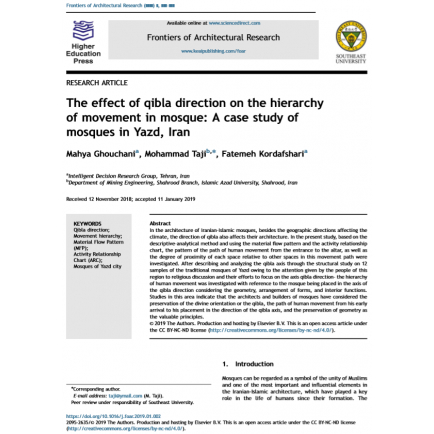
The effect of qibla direction on the hierarchy of movement in mosque: A case study of mosques in Yazd, Iran
Date Added
08/07/2019
Content Type
Documentary
Category
Researches
Link to Content
Subject Area
Architecture
Author
Mahya Ghouchania
Mohammad Tajib
and Fatemeh Kordafsharia
Publisher Name
Elsevier B.V.
Year of Publication
2019
1. Introduction 1.1. Literature review 2. Research method 3. Entrance hierarchy with regard to placing emphasis on the qibla axis 4. The Material Flow Pattern (MFP) 5. Conclusion
Description
In the architecture of Iranian-Islamic mosques, besides the geographic directions affecting the climate, the direction of qibla also affects their architecture. In the present study, based on the descriptive-analytical method and using the material flow pattern and the activity relationship chart, the pattern of the path of human movement from the entrance to the altar, as well as the degree of proximity of each space relative to other spaces in this movement path were investigated.
After describing and analyzing the qibla axis through the structural study on 12 samples of the traditional mosques of Yazd owing to the attention given by the people of this region to religious discussion and their efforts to focus on the axis qibla direction- the hierarchy of human movement was investigated with reference to the mosque being placed in the axis of the qibla direction considering the geometry, arrangement of forms, and interior functions.
Studies in this area indicate that the architects and builders of
mosques have considered the preservation of the divine orientation or
the qibla, the path of human movement from his early arrival to his placement
in the direction of the qibla axis, and the preservation of geometry as the
valuable principles.





